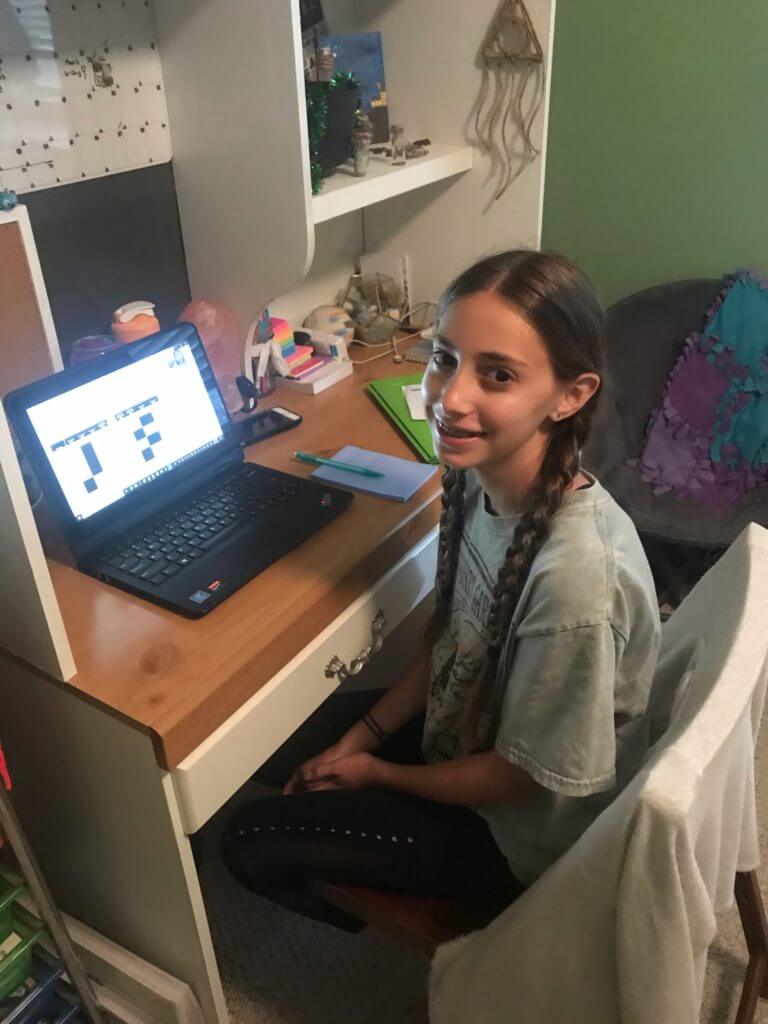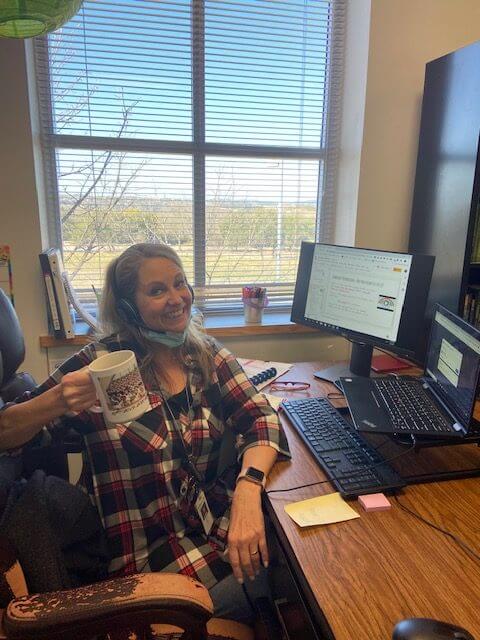
By APRIL GARNER , Four Points News
The COVID-19 pandemic is at the one-year mark and Leander ISD has worked hard to put protocols in place to continue educating students while helping prevent the spread of the virus. A glimpse of what’s happening inside the walls at Canyon Ridge Middle School show that yes, it’s been challenging but some new educational techniques and advantages have arisen. A teacher, parent and student all from Steiner Ranch share their experiences.
There are approximately 1,200 students enrolled at Canyon Ridge and about half are learning virtually. Only 24 people (staff and students) have tested positive for COVID-19 since the beginning of the school year showing that the protocols are working.
Block scheduling
To minimize time spent in crowded hallways, Canyon Ridge switched to block scheduling; there are A and B days, splitting eight class periods across the two. They’ve also mostly kept the same students together in pods to reduce close physical interactions, so students typically move from class to class with a consistent group.
Seventh-grader Savannah Buchner said that, while the A/B day scheduling can be confusing, she likes having longer class periods, especially for band. “At VHS, they have band at the end of every day, even with the A/B schedule,” she said, which she looks forward to when she reaches high school.
Sixth grade Language Arts teacher Laurie Zaza said she loves block scheduling. “It gives us an opportunity to go much deeper into the lesson and have extended work and individual conferencing time with students,” she said. However, it was a challenge at first to “relearn how to ‘chunk’ the curriculum into blocks.”
Virtual learning
Of about 1,200 students enrolled at Canyon Ridge, half or 604 have returned to in-person learning, according to the school’s COVID dashboard. That leaves close to 600 students still attending virtually. So, in any given classroom, around half of the students are connecting via Zoom from home.
Christy Schmitt, a parent of two Vandegrift students and one at Canyon Ridge, said virtual learning was rough at the beginning of the school year. “It took a few weeks to make sure my son was able to get into the class and was not missing his assignments,” she said, “but it’s pretty seamless now.”
Schmitt said, though their grades haven’t suffered, her kids feel like they are more engaged and attentive with in-person learning.
“When things return to normal, it would be nice to have the virtual option for kids who are out sick, so they don’t lose any instruction,” Schmitt said.
Teaching learning curve
Zaza admits there was a steep curve for teachers this year, learning to teach virtually and in-person simultaneously, but “most of us have discovered our groove,” she said.
Zaza mentions one perk of virtual learning: the private chat option. Students can touch base with the teacher during class without having to do it publicly, in front of their peers.
“Overall,” said Zaza, “our district and administration have been amazing at providing help, training and time for helping us adapt to all of the changes this year.” She said one of the best things to come out of virtual learning is students’ ability to attend class from the dentist’s office, the car, or vacation — times when they would normally miss out on instruction.
Lockers, phones
To promote social distancing, students don’t have access to lockers this year; those attending class in-person must carry their materials throughout the day. Thus, CRMS has had to change the “phones stay in lockers” policy, and teachers have developed their own rules regarding usage. Many allow phones to be out only at the end of the period after work is complete, but some students occasionally use their phones to access class Zoom sessions when laptops are not available.
Learning via video conference has not only allowed students to participate in class virtually, but it has permitted teachers to work from home when necessary (for example, for quarantine purposes). In such cases, a substitute teacher is physically present to manage the classroom in-person.
Social life
While students opting for in-person learning may have more opportunities to socialize than those who are virtual, due to the pod system and assigned areas for lunchtime seating, the social situation is still more limited than usual. Social relationships are important to teenagers as they practice for adulthood. Studies have found that young people with socially active lives tend to be emotionally and physically healthier, according to the Proceedings of the National Academy of Sciences.
“I think the social aspect of school is some of the best part of these years, and the kids are missing out on that. It’s important to learn how to work with others and work on projects together,” said Schmitt.
Zaza said this year has highlighted how vital it is to make a point to include socialization for both students and teachers. “We have learned to do what keeps our well-being at its best: social interaction time outside away from screens and moments of laughter and fun.”
CRMS student Buchner, who has attended school both virtually and in-person for different parts of the school year, said socially, the smaller, in-person classes are nice because “you get more one-on-one time with the teacher.” She notes that, though it’s been harder to see friends since the pandemic began, having technology and a phone for texting has made that a little easier.
Sanitizing procedures
Students’ hands are spritzed with sanitizer on the way into Canyon Ridge each morning and again upon entering each new classroom. Desks and chairs are sanitized between classes. Masks are ubiquitous. As Buchner notes, frequent hand cleaning introduces dry skin to some students for the first time, but it’s reassuring to parents and the community to know the school is taking consistent precautions.
The custodial staff at all Leander ISD schools has also been tasked with extra cleaning and sanitizing procedures in the face of the pandemic. While this may be a positive step in controlling the spread of the virus, it has taken its toll on custodians. According to a staff listening session conducted by LISD in October, custodial staff expressed the hardship extra procedures have placed upon them. One employee noted, “When one has a finite amount of time to do what is normally required of custodians, and they add more work to the shift, it does not fit. One cannot put 14 ounces in a 12-ounce can; it will not fit.”
Another responded, “One would have to compromise their work to fit [it] in the eight-hour shift. I will NOT compromise. My responsibility is the safety of my school and those in it.” Clearly, though the custodial staff is dedicated to doing their part to slow the spread, they are also feeling the stress of added duties.
Sanitizing is working because two dozen students and staff have tested positive for COVID-19 since the beginning of the school year, though the number of exposures is over 535.
The relatively small number of positive cases at CRMS can partly be attributed to the school’s commitment to sanitizing, mask-wearing and effective quarantining.
This has been a year that won’t easily be forgotten.
“I have a list of things I have said this year during teaching that I may never say again,” said Zaza, “Things like, ‘Is that a cat on your lap?’ and ‘Are you making mac and cheese right now, during the lesson?’ Answer: ‘No, Mrs. Zaza, I’m making pancakes.’”
According to Leander ISD’s website, exposure or “close contact” to COVID-19 is defined as:
- Within six feet for at least 15 minutes during the two days before the person got sick, up until when they began isolation,
- Sneezed or coughed on or somehow got the infected person’s respiratory droplets on you,
- Rode on a bus with the person for at least 15 minutes during the two days before the person got sick, up until when they began isolation,
- Cared for a COVID-19 infected person at home,
- Shared eating or drinking utensils with the person,
- Had direct contact (touched, hugged or kissed) with the person.
These factors determine who should quarantine at home when someone who has been at the school tests positive for COVID-19. The district site notes that additional considerations such as masking and ventilation may be taken into account.


